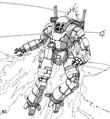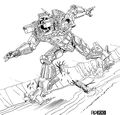Ostscout
Sarna News

- HEXTECH Review - Wave 3 Brings More Urban Options To Your Battlefield
- Your BattleTech News Round-Up For March, 2024
- Crashing 'Mechs With Jennifer Brozek, Author Of The Rogue Academy Trilogy
- Getting The Word Out With Rem Alternis, Catalyst Community & Marketing Director
- Bad 'Mechs - Yeoman
- Read more →

| |
| Ostscout | |
|---|---|
| Production information | |
| Manufacturer | Kong Interstellar Corporation (7J; destroyed 2802)[1]
|
| Production Year | 2600[2] |
| Model | OTT-7J[1] |
| Class | Light |
| Cost | 3,416,760 C-bills |
| Technical specifications | |
| 'Mech type | Inner Sphere BattleMech |
| Mass | 35 tons |
| Chassis | Kell/S |
| Armor | Durallex Light |
| Engine | VOX 280 |
| Communications System | Barret 4000 |
| Targeting Tracking System | TRSS.2L3 |
| Heat Sinks | 10 single |
| Speed | 129 km/h |
| Jump Jets | Ostmann Sct-A |
| Armament |
1x medium laser |
| BV (1.0) | 497[3] |
| BV (2.0) | 596[1][2][4] |
Contents
Description[edit]
The Ostscout was designed as a pure recon BattleMech by Ostmann Industries. To that end, it was built entirely around gathering data and getting out of trouble, tasks for which it is exceptional; the Ostscout is quick enough to escape most traps, and very few other designs can match it in terms of speed and maneuverability. However, its ability to run and leap out of danger came at the expense of offensive capability, and in fact, were it not for aggressive lobbying on the part of its test pilots the final production model would have been completely weaponless. As it is, the Ostscout would be hard pressed to win a fight against all but the lightest 'Mechs, but the 'Mech excels at operating deep behind enemy lines, gathering as much information as possible about the terrain and the disposition of enemy forces.[2][5]
Starting in 2600, Ostmann built and sold the Ostscout to fulfill many armies' need for a swift reconnaissance 'Mech, but eventually found that demand was outstripping their production ability. Rather than sacrifice their popular Ostroc line of urban-combat 'Mechs, the company licensed Kong Interstellar to start building the 'Mech in 2700, an arrangement similar to that struck regarding the Ostsol. Kong would continue to build Ostscouts for the next hundred years until the destruction of their factory on Connaught at the outset of the Succession Wars. Deprived of the possibility of replacement, many commanders began to hoard their Ostscouts like valuable treasure, parceling them out only for special missions, and most Ostscout pilots would not even attempt to engage enemy 'Mechs, as the advanced sensor system became extremely rare and nearly impossible to replace. This unwillingness to put the 'Mech in danger meant many survived the Succession Wars in practically mint condition, although many which suffered damage to their advanced sensors were forced to replace them with inferior, albeit more robust, systems.[2][5][6]
Besides the Great Houses, ComStar also utilized the Ostscout, and in the aftermath of the Clan Invasion and ComStar Schism began developing a new Ostscout variant for their Com Guards. This new model would maintain the same maneuverability and intelligence-gathering capabilities of the original while improving its offensive and defensive capabilities. Debuting with success in 3064, within the next three years nearly half of all Com Guard Ostscouts had been upgraded to the new variant; however it was soon discovered that both the Lyran Alliance and Word of Blake were fielding their own updated Ostscouts identical to ComStar's. The intelligence leak would be confirmed and traced back to Dag Kesselring, former Precentor of the 66th Division, who passed on information about the program to both the Lyrans and Blakists.[7]
Used by both sides in the Blakist Jihad, the newborn Republic of the Sphere would maintain production of the 11J model Ostscout after the fall of Terra both for its own relatively limited needs as well as export sales to the Federated Suns and Lyran Commonwealth.[8] Still produced during the Dark Age era, aside from the Krupp plant's combat focused Phoenix models both Kong Interstellar and Robinson Standard BattleWorks reintroduced variants that lean more heavily towards the original look and recon aspects of the venerable 7J model.[9]
Weapons and Equipment[edit]
The Ostscout carries a single Tronel II medium laser mounted in its center torso. This weapon, while not extremely powerful, is enough to dissuade most light scout assets from attempting to pursue. The 10 heat sinks the 'Mech carries is more than enough to handle the heat output of this single laser - indeed the Ostscout can jump 210 meters and fire laser at the same time without overheating at all. While it is protected by four and a half tons of armor, the real protection for the 'Mech is its speed and maneuverability, with a massive 16 ton fusion engine more commonly seen in 'Mechs twice its size propels the Ostscout to a cruising speed of 86.4 km/h. Eight jump jets built into the left and right torso give it a maximum jumping distance of 240 meters, rivaling that of the Spider.[2][5]
The true centerpiece of the design is its advanced sensor systems, including the TRSS.2L3 target-tracking system and powerful narrowband Barret 4000 comms system. The sensor arrays themselves are mounted outside the main chassis due to their delicate nature, with the Ostscout using its arms to aim them. Everything from hydrological to geological data is recorded, so much data in fact that the 'Mech's computer cannot process it fast enough. This forces the Ostscout to move slowly when traveling through an area of interest, waving its arms seemingly at random, which makes it one of the few times the 'Mech is vulnerable to the enemy. However so long as the enemy's first salvo doesn't cripple it, the Ostscout will likely escape from an ambush.[2][5]
Variants[edit]
- OTT-7Jb
- Introduced at the same time as the original model and used by the SLDF Royal units, the 7Jb is the only variant of the Ostscout built prior to the Clan Invasion. This variant uses endo steel to free up enough mass to add a Beagle active probe.[10] BV (2.0) = 610[11][12]
- OTT-7K
- The 7K Ostscout was introduced in 3050 and replaces the medium laser with a Garret Mole TAG laser designator, sacrificing its limited offensive capability to allow it to designate targets for Arrow IV artillery missiles. Otherwise, the 7K Ostscout is identical to the 7J model, and while utterly defenseless, is still swift enough to escape from most danger.[6] BV (1.0) = 372, BV (2.0) = 484[13]
- OTT-8J
- The Ostscout highly prized by the Draconis Combine, the 8J model is manufactured by the captured Robinson plant, sharing many parts with RSBW's Ostsol line. Using the classic 7J model as a base, the 8J uses a GM 280-rated XL engine to free up weight to upgrade its electronics suite to modern standards, being fitted with an Angel ECM suite and Bloodhound active probe. Offensively the Tronel II is swapped for a Martell-X medium X-Pulse laser supported by double heat sinks and six tons of StarGuard ferro-fibrous armor. BV (2.0) = 894[9]
- OTT-9CS
- The 9CS model is a complete upgrade of the venerable Ostscout, developed by ComStar and introduced in 3064. The 'Mech retains the jump jets but has otherwise been rebuilt from the ground up with a Krupp 255 endo steel internal structure, and a 280 VOX XL engine to free up weight for advanced electronics and weaponry. The arm-mounted sensor arrays were shifted to fixed points around the torso and included new side-scanning, Doppler, and triangulation sensors to maintain the same data-gathering capability. Additionally a new high-speed computer, capable of handling terabytes of data in seconds, meant the Ostscout no longer had to slow down when using its sensors. The targeting-tracking system was also replaced with a TRSS Eagle Eye system mated to a Beagle active probe, Guardian ECM suite, and head-mounted TAG, while the comms system was upgraded to the Exeter Longscan 300 with C3i computer for better fire mission coordination. For self-defense, the 9CS model carries two Diverse Optics ER medium lasers in either arm and a Diverse Optics ER small laser in its center torso. Finally six tons of Krupp 155 ferro-fibrous armor provides superior protection from weapons fire. BV (1.0) = 734, BV (2.0) = 940[14]
- OTT-9S
- The -9S model is also a rebuild of the Ostscout. This model also uses an endo steel chassis, as well as ferro-fibrous armor. For protection, the 'Mech carries two ER medium lasers and two A-Pods to discourage infantry attacks. The electronics carried by this 'Mech include a Beagle active probe, Guardian ECM suite, and a TAG laser designator. BV (1.0) = 631, BV (2.0) = 868[15]
- OTT-10CS
- Produced by Krupp Armament Works and Odin Manufacturing, the 10CS Ostscout saves weight through the use of an XL engine and an XL gyro, which gives up durability for more combat payload weight, allowing the 'Mech to jump up to 300 meters through the use of ten Rawlings 45i Improved Jump Jets. The 10CS also carries an improved C3 computer to communicate with similarly equipped units and carries two Diverse Optics ER medium lasers for defensive combat capabilities.[16][17]
- OTT-11J
- This variant is also produced by Krupp Armament Works. The top speed of the 'Mech is close to 150 km/h, thanks to a GM 315 XL engine, and it uses eight standard jump jets for enhanced mobility. Ferro-fibrous armor is utilized to offer enhanced protection, but all the advanced electronic equipment was removed, except for the TAG. The weapons and electronics are replaced by a pair of Moscovia light PPCs. BV (2.0) = 908[8][18]
- OTT-12R
- Spawned from an alliance between Kong and Clan Sea Fox, the 12R variant is outfitted with stealth armor technology and Clan weaponry. Clad in four and half tons of Starshield Ultra-Tech plating linked to a Guardian ECM suite, the 12R is built around a VOX 280 light fusion engine and a fragile endo-composite frame, allowing it to carry a single Clan grade Series 7K ER large laser to strike its foes at range. BV (2.0) = 1,209[9]
Design Quirks[edit]
The Ostscout has the following Design Quirks:[19]
Related BattleMechs[edit]
- Ostscout IIC - Clan Jade Falcon began a IIC-style redesign of the Ostscout in 3063. The design proved unsatisfactory, however, and was not put into full production.[20]
Notable Pilots[edit]
Notes[edit]
- The original image of the Ostscout was placed on the list of Unseen images in 1996. In 2011[21] it was removed from the list and became once again legal to use. When the decision was made to retcon the Unseen images, it was also decided to refresh the art for other early era 'Mechs, including the Ostscout.
- Author Blaine Lee Pardoe stated in a blog entry that, according to his memory which he admitted could be wrong, the Ostscout was among the BattleMechs for which he wrote the original background as initially published in TRO:3025, after being given only its name, image, and game stats to work with for the TRO entry.
Gallery[edit]
Original OTT-7J Ostscout from TRO:3025
OTT-7J Ostscout from TRO:SW
OTT-7K Ostscout from TRO:3050
OTT-9CS Ostscout from TRO:Phoenix
OTT-11J Ostscout from TRO:3085
Ostscout from House Davion
References[edit]
- ↑ 1.0 1.1 1.2 1.3 Technical Readout: Succession Wars, pp. 40–41: "OTT-7J Ostscout"
- ↑ 2.0 2.1 2.2 2.3 2.4 2.5 Technical Readout: 3039, p. 285
- ↑ Combat Operations, p. 107
- ↑ Record Sheets: 3039 Unabridged, p. 451
- ↑ 5.0 5.1 5.2 5.3 Technical Readout: 3025, p. 28
- ↑ 6.0 6.1 Technical Readout: 3050, p. 82
- ↑ Technical Readout: Project Phoenix, p. 22
- ↑ 8.0 8.1 Technical Readout: 3085, p. 235
- ↑ 9.0 9.1 9.2 Recognition Guide: ilClan, vol. 2, pp4-5 "Ostscout"
- ↑ Technical Readout: 3075, p. 169
- ↑ Record Sheets: 3075 Unabridged, p. 157
- ↑ Record Sheets: 3075 Unabridged - Age of War, p. 17
- ↑ Record Sheets: Phoenix Upgrades, p. 53
- ↑ Record Sheets: Phoenix Upgrades, p. 54
- ↑ Record Sheets: Phoenix Upgrades, p. 55
- ↑ Record Sheets: Phoenix Upgrades, p. 56
- ↑ "Boring Recon? No More!"
- ↑ Record Sheets: 3085 Unabridged — Project Phoenix, p. 44
- ↑ BattleMech Manual, p. 93 Design Quirk Table - Ostscout Entry.
- ↑ Experimental Technical Readout: Boondoggles, p.3
- ↑ Re: The Unseen - a Reseen IIC Explanation, and a List (Updated, December 2011)
Bibliography[edit]
- BattleMech Manual
- Boring Recon? No More!
- Combat Operations
- Experimental Technical Readout: Boondoggles
- Recognition Guide: ilClan, vol. 2
- Record Sheets: 3025 & 3026
- Record Sheets: 3039 Unabridged
- Record Sheets: 3050
- Record Sheets: 3067
- Record Sheets: 3075 Unabridged
- Record Sheets: 3075 Unabridged - Age of War
- Record Sheets: 3085 Unabridged — Project Phoenix
- Record Sheets: Phoenix Upgrades
- Technical Readout: 3025
- Technical Readout: 3039
- Technical Readout: 3050
- Technical Readout: 3075
- Technical Readout: 3085
- Technical Readout: Project Phoenix
- Technical Readout: Succession Wars
- Total Warfare Style Record Sheets: Phoenix Upgrades








